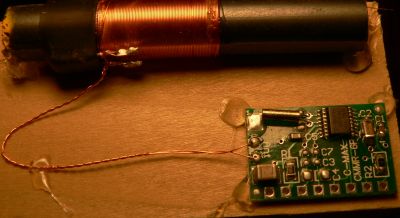 Non Broadcast Station MasterClock
Non Broadcast Station MasterClockApplication: RV Travel Trailer
| Master Clock Discussion |
 Non Broadcast Station MasterClock
Non Broadcast Station MasterClockApplication: RV Travel Trailer |
 Underside, prototype MasterClock
Underside, prototype MasterClock
|

|

|

|

|

|

C-Max from DigiKey About $10 |

 In addition, the PIC generates an error signal if the PIC determines that the pulse width is not either
a "Short" or a "Medium" or a "Long". These are the Zero, One, and Mark.
In addition, the PIC generates an error signal if the PIC determines that the pulse width is not either
a "Short" or a "Medium" or a "Long". These are the Zero, One, and Mark. Beside the rotating 1/8 second LEDs is a red LED for Correction to the Master Oscillator.
And next to it is the actual raw pulsing signal from WWVB.
Beside the rotating 1/8 second LEDs is a red LED for Correction to the Master Oscillator.
And next to it is the actual raw pulsing signal from WWVB.
 CMax receiver
CMax receiver
|
 Casing for receiver
Casing for receiver
|
 CMax receiver
CMax receiver |
 One of my clocks in a van.
One of my clocks in a van.
|
 Timer, Eraser, and Programer (burner)
Timer, Eraser, and Programer (burner)
|
 WWVB Mark signal has just Lit the yellow LED.
WWVB Mark signal has just Lit the yellow LED.
|

|
 I get good copy because I am running two measurement routines in the PIC.
I get good copy because I am running two measurement routines in the PIC.
 History of WWVB errors for the last 24 Hrs...
History of WWVB errors for the last 24 Hrs... This works so well because the carry is positioned for input BEFORE the shift. And the
register remnant is available
AFTER the shift in the carry.
This works so well because the carry is positioned for input BEFORE the shift. And the
register remnant is available
AFTER the shift in the carry.

 An internal 9volt battery engages
to keep the timekeeping alive.
I have placed the 9volt battery on a model that is a mobile clock so that the automotive battery power
may be disconnected. But I am abandoning this internal battery: the clock acquirers WWVB very quickly.
... Forget I even mentioned it. ... well, I guess it is too late.
An internal 9volt battery engages
to keep the timekeeping alive.
I have placed the 9volt battery on a model that is a mobile clock so that the automotive battery power
may be disconnected. But I am abandoning this internal battery: the clock acquirers WWVB very quickly.
... Forget I even mentioned it. ... well, I guess it is too late.
 Any unit receiving clock information.
Any unit receiving clock information.
|
CognizantWire Systems